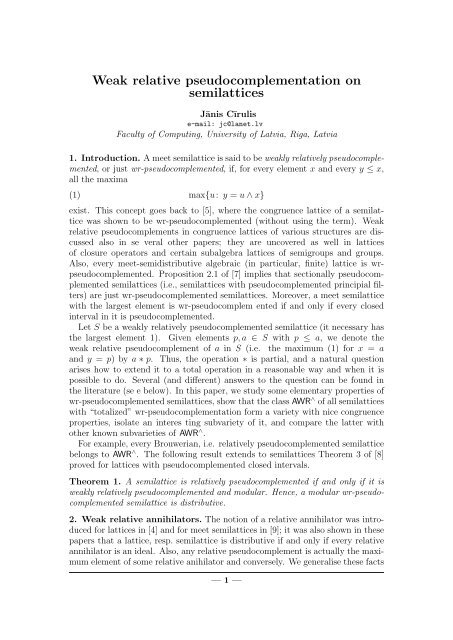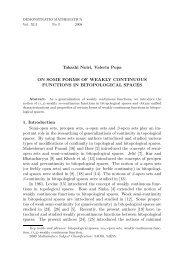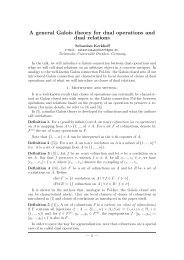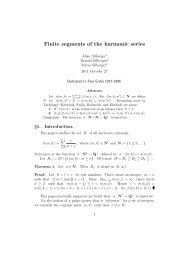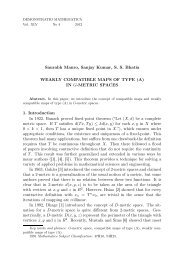Weak relative pseudocomplementation on semilattices
Weak relative pseudocomplementation on semilattices
Weak relative pseudocomplementation on semilattices
Create successful ePaper yourself
Turn your PDF publications into a flip-book with our unique Google optimized e-Paper software.
<str<strong>on</strong>g>Weak</str<strong>on</strong>g> <str<strong>on</strong>g>relative</str<strong>on</strong>g> <str<strong>on</strong>g>pseudocomplementati<strong>on</strong></str<strong>on</strong>g> <strong>on</strong><br />
<strong>semilattices</strong><br />
Jānis Cīrulis<br />
e-mail: jc@lanet.lv<br />
Faculty of Computing, University of Latvia, Riga, Latvia<br />
1. Introducti<strong>on</strong>. A meet semilattice is said to be weakly <str<strong>on</strong>g>relative</str<strong>on</strong>g>ly pseudocomplemented,<br />
or just wr-pseudocomplemented, if, for every element x and every y ≤ x,<br />
all the maxima<br />
(1) max{u: y = u ∧ x}<br />
exist. This c<strong>on</strong>cept goes back to [5], where the c<strong>on</strong>gruence lattice of a semilattice<br />
was shown to be wr-pseudocomplemented (without using the term). <str<strong>on</strong>g>Weak</str<strong>on</strong>g><br />
<str<strong>on</strong>g>relative</str<strong>on</strong>g> pseudocomplements in c<strong>on</strong>gruence lattices of various structures are discussed<br />
also in se veral other papers; they are uncovered as well in lattices<br />
of closure operators and certain subalgebra lattices of semigroups and groups.<br />
Also, every meet-semidistributive algebraic (in particular, finite) lattice is wrpseudocomplemented.<br />
Propositi<strong>on</strong> 2.1 of [7] implies that secti<strong>on</strong>ally pseudocomplemented<br />
<strong>semilattices</strong> (i.e., <strong>semilattices</strong> with pseudocomplemented principial filters)<br />
are just wr-pseudocomplemented <strong>semilattices</strong>. Moreover, a meet semilattice<br />
with the largest element is wr-pseudocomplem ented if and <strong>on</strong>ly if every closed<br />
interval in it is pseudocomplemented.<br />
Let S be a weakly <str<strong>on</strong>g>relative</str<strong>on</strong>g>ly pseudocomplemented semilattice (it necessary has<br />
the largest element 1). Given elements p, a ∈ S with p ≤ a, we denote the<br />
weak <str<strong>on</strong>g>relative</str<strong>on</strong>g> pseudocomplement of a in S (i.e. the maximum (1) for x = a<br />
and y = p) by a ∗ p. Thus, the operati<strong>on</strong> ∗ is partial, and a natural questi<strong>on</strong><br />
arises how to extend it to a total operati<strong>on</strong> in a reas<strong>on</strong>able way and when it is<br />
possible to do. Several (and different) answers to the questi<strong>on</strong> can be found in<br />
the literature (se e below). In this paper, we study some elementary properties of<br />
wr-pseudocomplemented <strong>semilattices</strong>, show that the class AWR ∧ of all <strong>semilattices</strong><br />
with “totalized” wr-<str<strong>on</strong>g>pseudocomplementati<strong>on</strong></str<strong>on</strong>g> form a variety with nice c<strong>on</strong>gruence<br />
properties, isolate an interes ting subvariety of it, and compare the latter with<br />
other known subvarieties of AWR ∧ .<br />
For example, every Brouwerian, i.e. <str<strong>on</strong>g>relative</str<strong>on</strong>g>ly pseudocomplemented semilattice<br />
bel<strong>on</strong>gs to AWR ∧ . The following result extends to <strong>semilattices</strong> Theorem 3 of [8]<br />
proved for lattices with pseudocomplemented closed intervals.<br />
Theorem 1. A semilattice is <str<strong>on</strong>g>relative</str<strong>on</strong>g>ly pseudocomplemented if and <strong>on</strong>ly if it is<br />
weakly <str<strong>on</strong>g>relative</str<strong>on</strong>g>ly pseudocomplemented and modular. Hence, a modular wr-pseudocomplemented<br />
semilattice is distributive.<br />
2. <str<strong>on</strong>g>Weak</str<strong>on</strong>g> <str<strong>on</strong>g>relative</str<strong>on</strong>g> annihilators. The noti<strong>on</strong> of a <str<strong>on</strong>g>relative</str<strong>on</strong>g> annihilator was introduced<br />
for lattices in [4] and for meet <strong>semilattices</strong> in [9]; it was also shown in these<br />
papers that a lattice, resp. semilattice is distributive if and <strong>on</strong>ly if every <str<strong>on</strong>g>relative</str<strong>on</strong>g><br />
annihilator is an ideal. Also, any <str<strong>on</strong>g>relative</str<strong>on</strong>g> pseudocomplement is actually the maximum<br />
element of some <str<strong>on</strong>g>relative</str<strong>on</strong>g> anihilator and c<strong>on</strong>versely. We generalise these facts<br />
— 1 —
for meet semi-distributivity and weak <str<strong>on</strong>g>relative</str<strong>on</strong>g> <str<strong>on</strong>g>pseudocomplementati<strong>on</strong></str<strong>on</strong>g> in S. In<br />
particular, a wr-pseudocomp lemented semilattice is meet-semidistributive in the<br />
sense that, for all x, y, z, p,<br />
if x ∧ y = p = x ∧ z, then p = x ∧ k for some k ≥ y, z.<br />
A weak annihilator 〈a, b〉 of a <str<strong>on</strong>g>relative</str<strong>on</strong>g> to b is the subset {x ∈ S : a ∧ x = a ∧ b}.<br />
Therefore, a ∗ p = max〈a, p〉 when p ≤ a. A semilattice in which max〈a, p〉 exists<br />
for all a and b is a semi-Brouwerian semilattice in the sense of [7].<br />
3. Extending wr-<str<strong>on</strong>g>pseudocomplementati<strong>on</strong></str<strong>on</strong>g>. We call a wr-pseudocomplemented<br />
semilattice S augmented if it is equipped with a total binary operati<strong>on</strong>,<br />
say →, extending ∗:<br />
(2) x → y = x ∗ y whenever y ≤ x,<br />
and c<strong>on</strong>sider such <strong>semilattices</strong> as algebras of kind (A, ∧, →, 1). Any operati<strong>on</strong> →<br />
satisfying (2) is an augmented wr-pseudocomplemntati<strong>on</strong>. Let us denote the class<br />
of all augmented wr-<strong>semilattices</strong> by AWR ∧ .<br />
We introduce the following useful abridgment:<br />
x ❀ y := x → (x ∧ y).<br />
Theorem 2. The class AWR ∧ is a variety characterised by the semilattice axioms<br />
and identities<br />
x ∧ (x ❀ y) ≤ y, y ≤ x ❀ y.<br />
We may c<strong>on</strong>sider semi-Brouwerian <strong>semilattices</strong> as augmented, where a → b<br />
stands for max〈a, b〉. Then x → y = x ∗ (x ∧ y). Hence, the class SBS of all<br />
semi-Brouerian <strong>semilattices</strong> is subvariety of AWR ∧ determined by the additi<strong>on</strong>al<br />
axiom x ❀ y = x → y. In particular, the algebra (A, ∧, ❀, 1) is always a semi-<br />
Brouwerian semilattice.<br />
Theorem 3. Every algebra A ∈ AWR ∧ is arithmetical at 1 and weakly regular at<br />
1 (1-regular). Hence,<br />
(a) A is c<strong>on</strong>gruence distributive,<br />
(b) the c<strong>on</strong>gruence kernels 1/θ of A form a lattice N(A),<br />
(c) the mapping θ ↦→ 1/θ is an isomorphism from the c<strong>on</strong>gruence lattice C(A)<br />
<strong>on</strong>to N(A).<br />
4. Pseudo-Brouwerian <strong>semilattices</strong>. Every c<strong>on</strong>gruence kernel of an AWR ∧ -<br />
algebra is a filter of its underlying semilattice. We now are going to find out when<br />
the c<strong>on</strong>verse holds. Given a filter F of an algebra S ∈ AWR ∧ , we denote by F ♯ the<br />
binary relati<strong>on</strong> {(x, y): a∧x = a∧y for some a ∈ F }. F is its kernel: 1/(F ♯ ) = F .<br />
Now, if θ is a c<strong>on</strong>gruence of S, then F = 1/θ if and <strong>on</strong>ly if θ = F ♯ .<br />
Theorem 4. A filter F is a c<strong>on</strong>gruence kernel if and <strong>on</strong>ly if the following holds<br />
in S for every x ∈ F (and all y, z):<br />
(3) x ∧ (y → z) = x ∧ ((x ∧ y) → (x ∧ z)).<br />
— 2 —
By a pseudo-Brouwerian semilattice we shall mean any AWR ∧ -algebra in which<br />
(3) is an identity. The name is motivated by the fact that all Brouwerian <strong>semilattices</strong><br />
bel<strong>on</strong>g to the variety PBS of all pseudo-Brouwerian <strong>semilattices</strong> and also<br />
t he following result.<br />
Propositi<strong>on</strong> 5. An algebra (S, →, 1) ∈ AWR ∧ is a pseudo-Brouwerian semilattice<br />
if and <strong>on</strong>ly if (S, ❀, 1) is a Brouwerian semilattice.<br />
The next two theorems are the main results of the paper. See [2] for the c<strong>on</strong>cepts<br />
of a c<strong>on</strong>gruence orderable and Fregean variety.<br />
Theorem 6. Let S be an AWR ∧ -algebra, and let F (S) be its lattice of filters.<br />
Then F (S) = N(S) if and <strong>on</strong>ly if S bel<strong>on</strong>gs to PBS.<br />
Theorem 7. The variety PBS is arithmetical and c<strong>on</strong>gruence orderable. Hence,<br />
it is Fregean.<br />
5. Some other subvarieties of AWR ∧ . Theorem 3 of [3] states that a meet<br />
semilattice with the greatest element is secti<strong>on</strong>ally pseudocomplemented if and<br />
<strong>on</strong>ly if it admits a (total) binary operati<strong>on</strong> → subject to axioms<br />
(4) x → x = 1, x ∧ (x → y) = x ∧ y, x → (x ∧ y) = x → y.<br />
Its proof implies that the operati<strong>on</strong> → obeys also (2). Against this background,<br />
secti<strong>on</strong>ally pseudocomplemented <strong>semilattices</strong> are treated in [3] as algebras of kind<br />
(S, ∧, →, 1) satisfying the above identities. The class SPSHK of all these algebras<br />
is thus a subvariety of AWR ∧ and include s SBS as a proper subclass.<br />
In [6], H.P. Sankappanavar defines a semi-Heyting algebra to be a bounded<br />
lattice with an additi<strong>on</strong>al operati<strong>on</strong> → fulfilling (3) and the first two identities in<br />
(4). He also proposes to call a semi-Brouwerian semilattice any meet semilattice<br />
with 1 and operati<strong>on</strong> → which is subject to these identities. Of course, this class<br />
SBSH of algebras differs from SBS; actually, it can be shown to be equal to PBS.<br />
On th e other hand, SBSH is a proper subclass of SPSHK. It is proved in [6],<br />
al<strong>on</strong>g with other results, that a semilattice S from SBSH has isomorphic lattices<br />
of filters and c<strong>on</strong>gruences and that S is subdirectly irreducible if and <strong>on</strong>ly if it has<br />
a unique (in fact, the greatest) coatom.<br />
One more proper subvariety of AWR ∧ , n<strong>on</strong>-comparable with those just c<strong>on</strong>sidered,<br />
is the class of secti<strong>on</strong>ally j-pseudocomplemented <strong>semilattices</strong> menti<strong>on</strong>ed in<br />
[[1], Corollary 4].<br />
References<br />
[1] J. Cīrulis, Implicati<strong>on</strong> in secti<strong>on</strong>ally pseudocomplemented posets, Acta Sci. Math. (Szeged)<br />
74 (2008) 477–491.<br />
[2] P. Idziak, K. S̷lomczinska and A. Wroński, Fregean varieties, Int. J. Algebra Comput., 19<br />
(2009), 595–645.<br />
[3] R. Halaˇs, J. Kühr, Subdirectly irreducible secti<strong>on</strong>ally pseudocomplemented <strong>semilattices</strong>,<br />
Czechoslovak Math. J., 57 (132) (2007), 725-735.<br />
[4] M.Mandelker, Relative annihilators in lattices, Duke Math. J. 37, (1970) 377-386.<br />
[5] D. Papert, C<strong>on</strong>gruence relati<strong>on</strong>s in <strong>semilattices</strong>, J. L<strong>on</strong>d<strong>on</strong> Math. Soc. 39 (1964), 723–729.<br />
[6] H.P. Sankappanavar, Semi-Heyting algebras: an abstracti<strong>on</strong> from Heyting algebras. In:<br />
Abad, Manuel e.a. (eds.), Proc. 9th “Dr. Ant<strong>on</strong>io A. R. M<strong>on</strong>teiro” c<strong>on</strong>gr. math., Bahía<br />
— 3 —
Blanca, Argentina, May 30–June 1, 2007. Bahía Blanca: Universidad Naci<strong>on</strong>al del Sur,<br />
Instituto de Matemática, 2008, 33-66.<br />
[7] J. Schmidt, Binomial pairs, semi-Brouwerian and Brouwerian <strong>semilattices</strong>. Notre Dame J.<br />
Formal Log., 19 (1978), 421–434.<br />
[8] J. Varlet, C<strong>on</strong>gruences dans les demi-lattis, Bull. Soc. Royale Sci. Liège 34 (1965), 231–240.<br />
[9] J.C. Varlet, Relative annihilators in <strong>semilattices</strong>. Bull. Austral. Math. Soc. 9 (1973), 169-<br />
185.<br />
— 4 —


